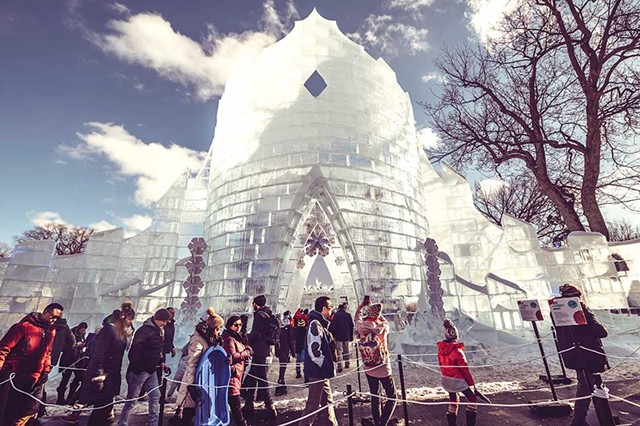
- Courtesy Of Carnaval De Québec
- Carnaval de Québec ice palace
The air is crisp, my skin is the color of a Queen Anne rose, and I'm dressed in so many layers I could pass for Bonhomme's short, plump sister. He's around here somewhere, Bonhomme, the King of Carnaval de Québec. My eyes are peeled for the host of the party as I wander the cobblestone streets of Old Québec, belly up to the ice bars and watch ice canoe races on the freezing Saint Lawrence River.
Drawing some 500,000 residents and visitors each year, Carnaval de Québec is Québec City's signature outdoor winter festival and one of the largest in the world. This year it runs from January 25 to February 11 — eight more days of merriment than usual, to mark its 70th anniversary. The carnival transforms the frigid city into a playful snow fort brimming with bright lights, music, food, entertainment and only-in-Québec sports.
For Vermonters looking to get in on the fun, here's how to make the most of one of the best winter carnivals on the continent — just a four-hour drive northeast from Burlington.
Mardi Gras North
Winter in Québec City is longer, darker and colder than Vermont's. In 1894 former provincial premier Henri-Gustave Joly de Lotbinière and a group of businessmen came up with an idea to brighten it up: a vibrant carnival with music, dancing, food and an ice palace in front of the Parliament Building. The biggest draw was a canoe race across the icy river that has shaped the historic city. The sport — dubbed "ice canoeing" today — honored hundreds of years of river crossings, and locals lined up along both banks to cheer.
The carnival was a hit and became a winter tradition until World War I. In the decades that followed, it happened sporadically but had stopped entirely by the end of World War II. In the 1950s came talks of rejuvenating Old Québec, later named a UNESCO World Heritage Site, and increasing winter tourism. City boosters determined the answer was to bring back the annual winter carnival, and in 1955 Carnaval de Québec was born, along with Bonhomme. Named to embody winter — "snowman" in French is bonhomme de neige — he is the spokesperson of the carnival.
Meet His Highness, Bonhomme
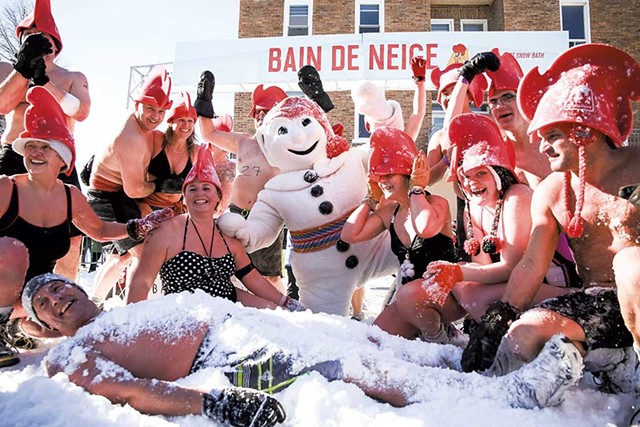
- Courtesy Of Stéphane Audet/destination Québec Cité
- Bonhomme at a snow bath
Searching the city for the rotund, seven-foot-tall smiling snowman is an unofficial carnival game. Bonhomme's crown is a red tuque, and there's an arrow sash around his waist. His joie de vivre is more contagious than the latest strain of coronavirus.
"If Bonhomme walks into a bar, for sure everyone is going to cheer and want to meet him," said Jean-Luc St-Amand, a local resident who recently retired from the city's Musée de la Civilisation and has attended Carnaval de Québec many times. "In my twenties, carnival was a big party; people were drunk the entire time. Now it is a family event, and Bonhomme is more popular than Santa Claus.
"It doesn't matter how cold it is outside — it could be minus 40 degrees Celsius — we will be outside to cheer for Bonhomme," he added.
During Carnaval, Bonhomme saunters around Old Québec like a movie star, snapping selfies with his fans and cheering on the ice canoe races. He also loves a sip of caribou — the festival's official drink — made with port, sherry, vodka and brandy.
Taste the Local Tipple
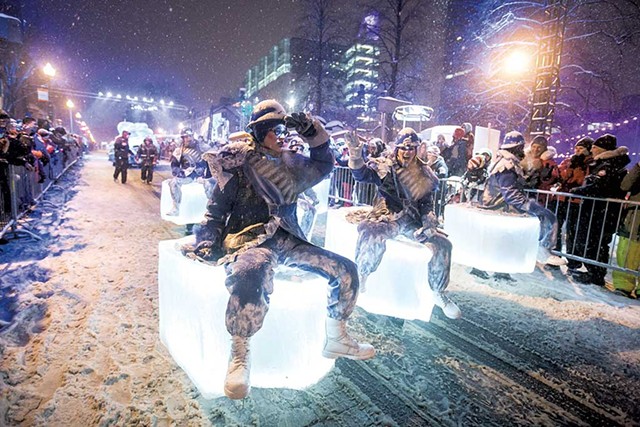
- Courtesy Of Frédéric Lavoie/destination Québec Cité
- Night parade at Carnaval de Québec
Legend has it that caribou originated in the 17th century, when colonists concocted the beverage to get through the harsh winter months. Some believe they added whisky to caribou blood, hence the drink's name. Another theory is that the moniker came from Indigenous peoples who thought the combination of red wine and whisky tasted like caribou blood.
"Caribou tastes similar to mulled wine, except you will be drunk quicker. It's a mixture of red wine with 90 percent alcohol — after a few shots, you will forget it's cold outside," said Shadi Greco, a bartender at the historic Québec City tavern Pub l'Oncle Antoine.
"I prefer caribou to mulled wine. It's more earthy and warming," added Catherine Parisot, the pub's owner.
Caribou recipes vary within the regions of Québec. Some are made strictly with wine, others with fortified wine, whisky or vodka, and a few spices. Try the drink at one of the outdoor ice bars or inside a warm restaurant or pub, then chase it with a shot of Sortilège maple whisky.
Pro tip No. 1 for tourists: During Carnaval, caribou is sold in a red plastic Bonhomme cane that you can sip as you wander. Quebec's drinking age is 18, and its open-container law makes an exception for this festive vessel. (For a reminder that good things are best imbibed in moderation, see "Northern Exposure.")
Party in the Palace
The cultural centerpiece of the carnival is Bonhomme's 840,000-pound ice palace just outside the fortified walls of the Old City. It has intricately carved designs and multiple rooms to explore, and the King of Carnaval drops by daily to meet his subjects. To the right of his palace is an outdoor stage for concerts; to the left, an ice bar and bistro. Known as Zone Loto-Québec, this is also one of the locations where you can pick up $34.50 carnival passes for visitors 13 and older. That's $25.62 in U.S. dollars. (Kids 12 and under are admitted free.)
It's a short walk to Carnaval de Québec's other main sites. Bonhomme's Campground in Parc de la Francophonie is perfect for families during the day. Kids will love the fairground games, ice slides and zip line. There's also a warming hut and food shack. After sunset, it's an adult playground with drag shows and karaoke. Across the street, in Place George V, is Jardin des sculptures, home to stunning ice sculptures, an ice bar and maple taffy.
The site Gougoune et Doudoune, also known as Bonhomme's winter beach, features a 45-foot bear-shaped ice-climbing structure. Find a tiki bar, ball-pit pool, ski trails and succulent barbecue eats, too. Nearby is Québec City's marina, which sees more action during the carnival than at any other time of the year. It's also close to Village Nordik, an urban ice fishing spot open to locals and tourists alike.
An Icy Itinerary
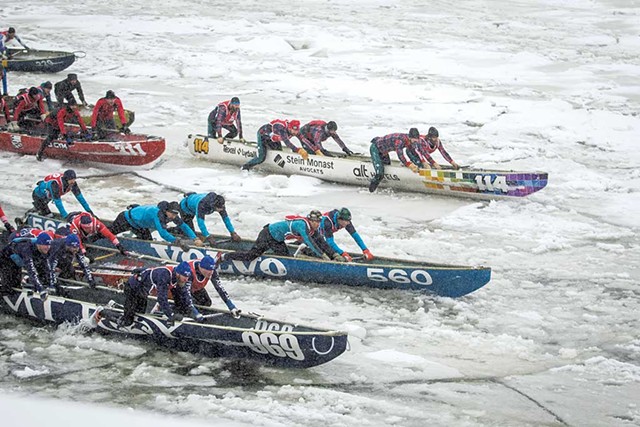
- Courtesy Of Frédéric Lavoie/destination Québec Cité
- Ice canoeing at Carnaval de Québec
An admirable embrace of winter is on full display at Carnaval de Québec. While many events and activities take place within the 18-day festival, others are one-offs that are worth planning your trip around. The festivities kick off on January 25 with a free party at Place Jean-Béliveau near Grand Marché de Québec. Expect dancing, pyrotechnics, and performances by Québec artists such as rock singer Rémi Chassé, rapper Sarahmée and comedian Mathieu Dufour.
The fest picks up again on February 2, when partiers can dance to deejayed beats while wearing wireless headsets at a silent disco chez Bonhomme's Campground; don glow sticks and jump in the ball-pit pool at a Neon Pompom Party at Gougoune et Doudoune; and groove to Québec hip-hop artists Loud and Mindflip at Zone Loto-Québec.
Dancing is practically a requirement to keep the blood flowing at these outdoor concerts. Pro tip No. 2: Stuffing one's boots with newspaper or bringing a piece of cardboard to stand on can be a lifesaver if temperatures drop below minus 20 degrees Celsius — that's minus 4 Fahrenheit. The warming hut at Bonhomme's Campground comes in handy, too.
On February 4, you can join hundreds of onlookers to watch teams paddle across the river, stopping to walk over chunks of ice, trying not to fall in.
"When you're in the middle of the river, you have to be very focused on the speed of the ice and try to find a path," said Remi Gilbert, who has been competing in ice canoe races since 1988. "The ice is very loud, and with the canoe, the noise doubles. We have to scream to hear each other."
Think you can do it? It's a carnival tradition that anyone can try.
For the less adventurous, Gougoune et Doudoune hosts culinary sampling events from 2 to 4 p.m. on the weekends — a tasty way to enjoy local cuisine without spending a lot of money. Look for renowned chefs Frédéric Cyr of Fairmont Le Château Frontenac and Raphaël Vézina of Laurie Raphaël on February 10 and 11.
There's a frozen mustache contest on February 9, and February 5 through 8 brings laser tag and music to La Citadelle de Québec — a historic site and active military base. You won't find that anywhere else.
Closing out the carnival on February 11 is the snow bath, in which participants don their swimsuits to play in the snow while bystanders bundled in head-to-toe winter gear cheer them on.
Know Before You Go
Québec City is walkable, but in winter wearing ice cleats is always a good idea. It's also a hilly city. When your feet are tired, hop on a bus and show your carnival pass to ride for free.
Inside the city's fortification walls, the streets of Old Québec will be busy, which is why most locals stick to the side streets or hang out elsewhere. Go to Montcalm to wander Musée National des Beaux-Arts du Québec, an art museum with a 42,000-piece collection dating back to the 17th century. Skip the busy restaurants in Old Québec and eat instead in neighborhoods such as Saint-Roch, Limoilou and Saint-Sauveur. Saint-Jean-Baptiste, just outside the old city walls, is great for bar hopping. It's also home to Le Drague, the city's only LGBTQ+ club.
Visit the snow-covered Montmorency Falls, take a free walking tour of the city and eat poutine. For pretty views, ride the Québec-Lévis ferry, stand at the scenic junction of rues Cul-de-Sac and Notre-Dame, or go to Terrasse Pierre-Dugua-de-mons, a lookout point offering a panorama of the Saint Lawrence River and the iconic 1893 Château Frontenac.
Staying in Québec City
Finding hotel rooms in Old Québec during the carnival can be a challenge, especially on the weekends when outdoor concerts and special events take place. The farther you venture from Old Québec, the more luck you'll have finding accommodations, and with free bus transportation for those with carnival passes, this is sometimes the best option.
Big hotel chains such as Fairmont Le Château Frontenac, Delta, Hilton, Marriott and Germain have properties in or very close to the old city walls and generally have last-minute rooms. Most have large parking garages or parking lots close by, a welcome amenity in winter.
As an alternative, there are several small hotels and B&Bs in Old Québec to choose from. Hôtel Nomad, Hôtel Manoir Victoria and Monsieur Jean are among the more popular. Monastère des Augustines is a monastery turned health and wellness retreat.
For those seeking even more in the way of winter, there's the Hôtel de Glace. The only ice hotel in North America is 30 minutes northwest of Québec City.
Northern Exposure
I do not recall how my husband (then-boyfriend) and I decided to go to Québec City for the winter carnival back in the late 1980s. I do vividly remember how freezing cold we were the whole time.
Mark was in his first year of graduate school in Burlington, and I was still working in New York City. We had very little money and saved up our pennies to see each other every few weeks.
The Québec trip was a big deal for us, and in that pre-internet era I relied on printed guidebooks and the phone to find and book what I thought would be a charming but affordable hotel in Old Québec.
Another vivid memory: The furniture in our room was upholstered entirely in orange vinyl — and the 1970s were too recent for that to be retro-charming.
Coming from Vermont and New York City, we should have known well enough to bring appropriate clothing and footwear. But the polar depths of cold we experienced that weekend were beyond anything either of us could have imagined.
Bundled up in every item of clothing we brought, we headed out to stroll among the ice sculptures. That lasted only briefly, as our appendages soon began to resemble the art.
Also: We were puzzled by all the jolly, seemingly warm people walking around. Most were outfitted in full ski suits, and many were carrying tall red-and-white canes with a little snowman head on them. We noticed that every so often they would stop, decapitate the snowman and take a swig.
Clearly, we needed to acquire a cane and whatever was in it.
The snowman on the cane, we learned, was Bonhomme, the embodiment of the winter carnival. And the spirit everyone was sipping was a potent mix of alcohol called caribou.
After buying a cane, we quickly sought refuge in a bar to warm up and inquire about filling it. Mark ordered a beer, and the barkeep slid two over to us along with two shot glasses. It was a carnival special, the guy told us: Buy one beer, get one free — and every beer came a shot of caribou.
It took a few beers to get the feeling in our fingers back. We poured all the shots of caribou into Bonhomme's long body.
The afternoon proceeded with us staying outdoors as long as possible, fortified by slugs of caribou from our cane, alternating with stops in a series of bars to regain feeling in our fingers, toes and noses.
The beer plus free beer plus free shots seemed to be a citywide practice. Needless to say, things eventually took a queasy turn. We had to cut short our dinner of wild Québec game and head back to the hotel to collapse amid orange vinyl.
Many years later, we laugh at our naïveté and keep the Bonhomme cane in the basement as a reminder to never underestimate the weather. Mark admitted recently that he still shudders when he sees the snowman's "little smiling face, mocking me for being so ill-prepared for the Québec cold."
— Melissa Pasanen

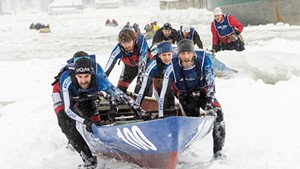









Comments
Comments are closed.
From 2014-2020, Seven Days allowed readers to comment on all stories posted on our website. While we've appreciated the suggestions and insights, right now Seven Days is prioritizing our core mission — producing high-quality, responsible local journalism — over moderating online debates between readers.
To criticize, correct or praise our reporting, please send us a letter to the editor or send us a tip. We’ll check it out and report the results.
Online comments may return when we have better tech tools for managing them. Thanks for reading.